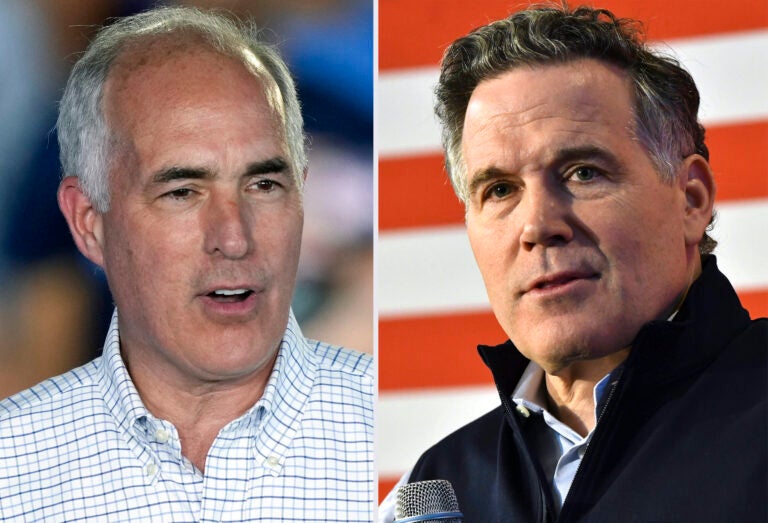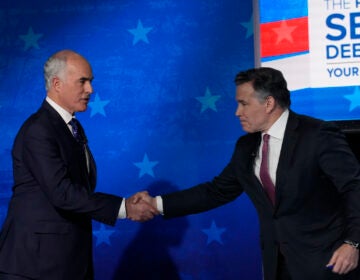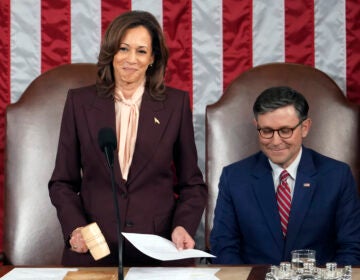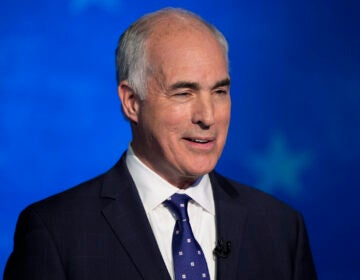$240M floods Pa. Senate race; McCormick’s super PAC leads in spending
Super PAC money dwarfed the candidates’ own spending. Millions from GOP megadonors have helped McCormick offset a smaller fundraising haul.

This combination of photos taken in Pennsylvania shows Sen. Bob Casey, D-Pa., left, at a campaign event, Sept. 13, 2024, in Wilkes-Barre, and David McCormick, the Republican nominee for Senate in Pennsylvania, at a campaign event, April 25, 2024, in Harrisburg. (AP Photo)
What questions do you have about the 2024 elections? What major issues do you want candidates to address? Let us know.
Megadonor money is flooding the Pennsylvania Senate race between three-term incumbent Democrat Bob Casey and Republican challenger David McCormick. Super PACs are vastly outspending the candidates’ own campaigns, according to the most recent Federal Election Commission reports.
McCormick’s campaign has raised and spent about half as much as his opponent’s, but an influx of outside dollars has pushed him ahead of Casey in spending. That may have helped McCormick as recent polling shows McCormick gaining ground on Casey. A recent New York Times poll has Casey with a 4-point lead this week, whereas they gave him a 14-point lead in August.
The McCormick campaign’s $22.2 million in spending has been cushioned by over $108 million from various outside groups. Of that, $45.3 million is from a super PAC called Keystone Renewal, which receives a majority of its funding from roughly 70 donors. Super political action committees, or super PACs, may receive unlimited contributions from individuals, corporations, labor unions and other PACs but must spend it independently of the candidates they support.
Instead of supporting multiple candidates, Keystone is solely focused on flipping the Pennsylvania seat. And the campaign has amassed million-dollar donations from some of the wealthiest individuals in the world, including Jeffrey Yass, the richest man in Pennsylvania, and former education secretary Betsy DeVos.
The numbers aren’t completely surprising, according to OpenSecrets researcher Andrew Mayersohn. He said that before the pivotal Citizens United case of 2010, which enabled unlimited outside spending in elections, outside spending groups were relatively small players in most of the campaign finance landscape. Those groups, and the megadonors who often power them, now have a disproportionate presence in races.
“Every cycle, we’re seeing the top Senate races get into the nine figures of outside spending,” Mayersohn said. “It means, in all likelihood, a larger reliance on things like attack ads, because that’s a specialty of outside groups.”
The ubiquity of attack ads has also been shown to have a negative impact on voter enthusiasm and trust in the political system, which concerns some experts.
“The vast majority of the Casey versus McCormick race has been negative,” said Heather LaMarre, who studies political communications and teaching at Temple University. “Political campaign ads in general, especially negative ads, [are] a net negative for our democracy and neutral at best for a campaign or candidate and probably a net negative” for them, as well.
While super PACs and campaigns cash out on television and internet ads, physical mailers, billboards and more, campaign committees have a broader range of expenditures to cover, such as overhead costs, staff compensation, travel, campaign events and more.
Casey, for his part, has spent $45 million this election cycle. Though he did not benefit from a single-candidate Super PAC, he did see $67 million spent on his behalf by outside groups.
About $50 million of that comes from leadership PACs (PACs controlled by party leaders), which also receive large contributions from wealthy megadonors, such as James Simons, a former hedge fund manager who donated more than $15 million to Democratic organizations this year before he died in May. The primary difference is that Simons’ contributions went into a pot of money doled out to Senate campaigns across the country.
More than $173 million in outside expenditures has been poured into this race, according to OpenSecrets, dwarfing both candidates’ combined spending of $68 million. With over $240 million spent in total, the race is among the most expensive in the nation.
According to FEC reports, Casey’s campaign raised $16 million this quarter, compared to $7.6 million for McCormick.
The Donors
The Koch-affiliated hybrid PAC Americans for Prosperity Action has spent significantly in support of McCormick, $13 million in the most recent quarter.
But Keystone Renewal remains the largest spender in the race. The super PAC reported spending $30 million on McCormick’s campaign in the last quarter alone.
Only two of Keystone’s donors, including Yass, are from Pennsylvania. The group’s focus solely on McCormick’s campaign, rather than a wider slate of Republican candidates, shows how much megadonors are willing to spend to influence the outcome of this race.
DeVos, the secretary of education during the Trump administration, and other members of her family collectively gave $500,000 in May of this year, but had no additional donations listed this quarter.
Kenneth Griffin, founder of the hedge fund Citadel LLC, gave the PAC the largest boost of all in its first month with a $10 million contribution. He donated another $5 million this quarter.
Blackstone CEO Stephen Schwarzman donated $1 million this quarter following a gift of $500,000 last year. Thomas Peterffy, the founder and CEO of the trading firm Interactive Brokers, gave $2 million this quarter after an initial $800,000. Yass gave an initial $1 million shortly after the PAC launched and added another $250,000 this quarter.
These four Keystone contributors — Griffin, Schwarzman, Peterffy and Yass — rank between numbers 28 and 38 on Bloomberg’s global Billionaires Index.
Many donors who are closely connected with former President Donald Trump also cashed in for McCormick, who has said that he sees the two campaigns as “very aligned” in terms of reaching voters.
Another first-quarter $1 million dollar investor is billionaire Howard Lutnick, who Trump appointed in August as co-chair of a transition team preparing for his potential return to office.
Valor Equity Partners founder and former Tesla board member Antonio Gracias also joined the GOP donors this quarter with $2 million in donations. Gracias is a close friend and confidant to Elon Musk, and also contributes to his own pro-Trump super PAC.
Billionaire couple Richard and Elizabeth Uihlein, founders of the shipping company Uline and among the top financial contributors to the Trump campaign in the nation, have given a total of $1.5 million to Keystone. Richard Uihlein is the primary contributor to the pro-Trump group Restoration PAC, which recently made headlines for a controversial pro-Trump TV ad using out-of-context footage of Philadelphia native Kimberly Burrell.
On Casey’s side, most of the outside PAC spending has come from leadership super PAC WinSenate, which spent $39 million on the candidate. WinSenate’s funding comes directly from Senate Majority PAC (SMP), which is aligned with Senate Majority Leader Chuck Schumer.
SMP fundraises for Democratic Senatorial candidates across the country, providing less of a direct look at which wealthy contributors are eyeing Casey in particular, but there are plenty of megadonors among their ranks. In addition to Simons, Stephen Mandel, founder and manager of Lone Pine Capital, another hedge fund, chipped in $6 million to SMP before this quarter. Newsweb Chairman Fred Eychaner donated $8 million and Reed Hastings, chairman of the board of directors at Netflix, gave $2 million.
SMP also received over $15.7 million from Majority Forward in 2023. That group is considered a “dark money” nonprofit — its 501(c)(4) status allows the organization to spend to influence elections without disclosing its donors.
McCormick saw a similar sum spent on his behalf by a party-controlled, multi-candidate super PAC. The Senate Leadership Fund, aligned with Senate Minority Leader Mitch McConnell, has doled out $37 million for McCormick throughout the course of the race.
Both SMP and the Senate Leadership Fund get the lion’s share of their funds from donations larger than $200, though SMP brings in some small-dollar gifts.
The Democratic super PAC reported that donations under $200 made up about 10% of their $55 million in fundraising between January and July 2024, while Senate Leadership Fund reported virtually none in their $65 million haul over the same time period.
Pro-gun regulation groups such as Everytown for Gun Safety Victory Fund spent more than $1 million and Giffords PAC spent nearly $500,000 on Casey’s campaign. The National Nurses United for Patient Protection spent nearly $500,000 on Casey’s campaign and the American Federation of State, County and Municipal Employees (AFSCME) spent $400,000.
The overall effect of the massive outside spending is an abundance in ads produced by both sides, many of which are attacking each other. With other super PAC spending on the presidential race and others, Pennsylvania is witnessing the results.
“I can’t come up with a logical, rational explanation of why they’re putting 10 billion into negative advertising when they know there is diminishing returns and all the science says it’s not working other than they just are afraid to stop,” LaMarre said. “They’re afraid of one side, it’s sort of like a nuclear arms race of advertising at this point. What if we stop, but they don’t stop? Then will that hurt us? And we don’t know because one side hasn’t stopped.”

Get daily updates from WHYY News!
WHYY is your source for fact-based, in-depth journalism and information. As a nonprofit organization, we rely on financial support from readers like you. Please give today.







